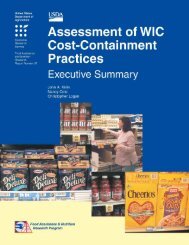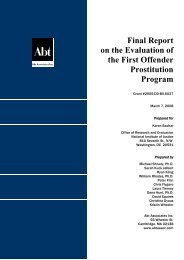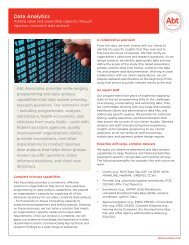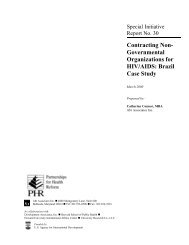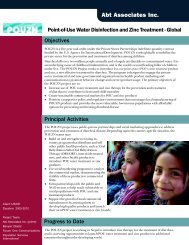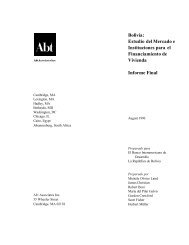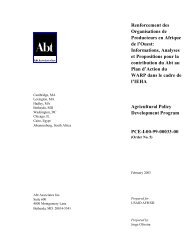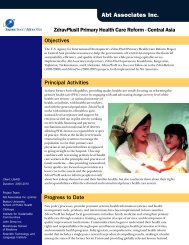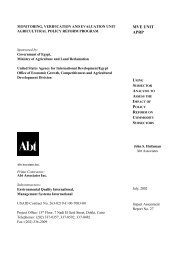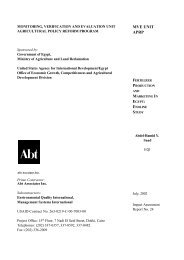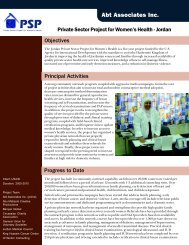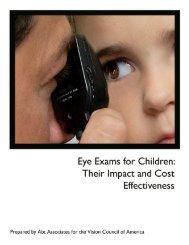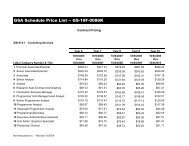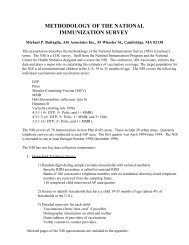What America's Users Spend on Illegal Drugs 1988-2000 - National ...
What America's Users Spend on Illegal Drugs 1988-2000 - National ...
What America's Users Spend on Illegal Drugs 1988-2000 - National ...
- No tags were found...
You also want an ePaper? Increase the reach of your titles
YUMPU automatically turns print PDFs into web optimized ePapers that Google loves.
We used the SRHT findings to adjust our estimates of truthfulness. Essentially, we figured thatto achieve the 75 percent truthful reporting rate in Cook County, we would need to increase theabove estimates of truthfulness by 1.167. (That is, if the above estimate was that X percent weretruthful, we increased this to 1.167X.) We assumed this adjustment would hold for all sites andtherefore adjusted the provisi<strong>on</strong>al rate, for each year and for every site, by 1.167. Then toaccount for underreporting, we divided the estimate of chr<strong>on</strong>ic drug users based <strong>on</strong> self-reportsby the adjusted estimated proporti<strong>on</strong> of arrestees who answered truthfully. 9Step four was a simple adjustment for the fact that the calculati<strong>on</strong>s to this point are for men.According to the FBI, men account for about 78 percent of all arrests, so we increased theestimates by 1/0.78 or by 1.28. In the past we separated estimates for men and women, but theDUF data are unavailable for women at several sites, and even when female data are available,we are skeptical of how well they represent female arrestees.These four steps provided an estimate of the number of chr<strong>on</strong>ic cocaine users am<strong>on</strong>g arrestees inNew York City. The next step was to divide this estimate by the rate at which chr<strong>on</strong>ic drug usersget arrested. We are necessarily uncertain about this multiplier because researchers have seldomsought to estimate arrest rates that are suitable for our use, and furthermore, extant arrest rateestimates are for selected sites and specific periods. 10 Based primarily <strong>on</strong> available evidence froma 1995 addendum to the DUF survey, we assumed that chr<strong>on</strong>ic cocaine users generate an averageof about 0.4 arrests per year, which implied that there are about 2.5 chr<strong>on</strong>ic cocaine users in thecounty for every chr<strong>on</strong>ic cocaine user in the arrestee populati<strong>on</strong>. 11In the sixth step, we sought to extend the estimates for New York City to the New YorkMetropolitan Statistical Area. To make this extensi<strong>on</strong>, we multiplied the estimated number ofchr<strong>on</strong>ic cocaine users in New York City by the ratio of the number of arrests for drug lawviolati<strong>on</strong>s in the New York MSA to the number of arrests for drug law violati<strong>on</strong>s in New YorkCity proper. For New York City, the adjustment was about 1.06; across all sites the average size9 The previous c<strong>on</strong>sumpti<strong>on</strong> report employed a similar logic to estimate a global truthfulness rate. For this currentversi<strong>on</strong> of the c<strong>on</strong>sumpti<strong>on</strong> report, we allow the truthfulness rate to vary by year and by site.10 The Arrestee Drug Abuse M<strong>on</strong>itoring program will overcome this problem starting in <strong>2000</strong>. The ADAMinstrument includes a calendar that captures an arrestee’s booking profile over the year before the interview.Furthermore, the Nati<strong>on</strong>al Institute of Justice is sp<strong>on</strong>soring a methodology study for using those booking profiles todevelop chr<strong>on</strong>ic drug user estimates. Essentially, results from that study will provide arrest rates for applicati<strong>on</strong> topre-<strong>2000</strong> DUF data and chr<strong>on</strong>ic user estimates themselves for the year <strong>2000</strong> forward. Estimates from that chr<strong>on</strong>icuser estimati<strong>on</strong> methodology could replace all the steps described to this point in this appendix.11 Previous versi<strong>on</strong>s of <str<strong>on</strong>g>What</str<strong>on</strong>g> America’s <str<strong>on</strong>g>Users</str<strong>on</strong>g> <str<strong>on</strong>g>Spend</str<strong>on</strong>g> <strong>on</strong> <strong>Illegal</strong> <strong>Drugs</strong> used a slightly smaller multiple. Weincreased the multiple this year because analysis of booking data from six sites in 1995 suggested that previousestimates were too low. We used the same rate for methamphetamine users. C<strong>on</strong>sistent with past versi<strong>on</strong>s of thisreport, we assumed that chr<strong>on</strong>ic heroin users have a slightly larger arrest rate. We assigned them a multiple of 2.25.SRHT provided the <strong>on</strong>ly other estimate that used a methodology similar to the <strong>on</strong>e that we used to estimate arrestrates from the six sites. SRHT provided a range from 0.27 to 0.38 arrests per year for chr<strong>on</strong>ic drug users in CookCounty. Estimates used in our current study are c<strong>on</strong>sistent with the upper end of the SRHT range for arrest rates.We are c<strong>on</strong>ducting a rigorous analysis of arrest rates for the Nati<strong>on</strong>al Institute of Justice. While results are not yetavailable, provisi<strong>on</strong>al results reported at three nati<strong>on</strong>al meetings suggest that multipliers between 2 and 3 are aboutright for most sites.40



